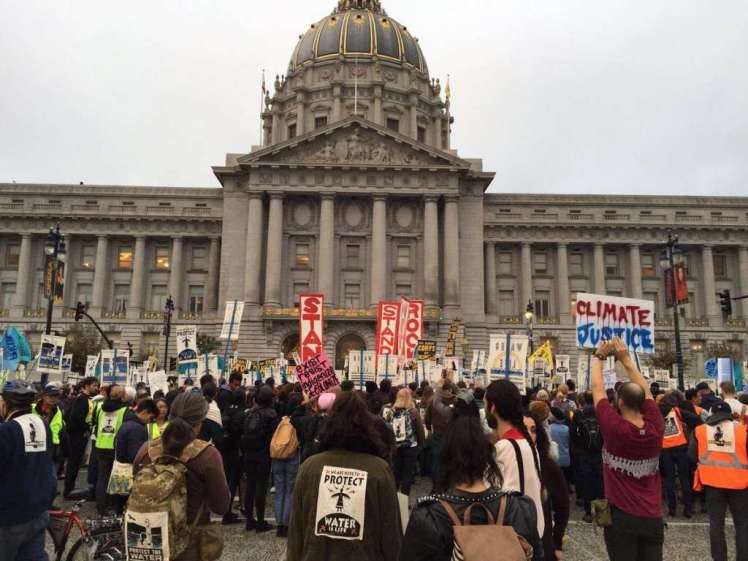For once we’re actually covering a recent event that has been directly discussed in our Humanities Core Lecture and Discussion! That’s right, you probably guessed it (from the title, because who doesn’t read the title before they read the actual content), its the Dakota Access Pipeline Protests! Today I’ll be talking about what aspects of this protest link back to US history, especially so with Manifest Destiny.
 Oh look, it’s that one picture everyone has seen in their history class!
Oh look, it’s that one picture everyone has seen in their history class!
So what exactly has been happening so far? Well thanks to Professor Ricci’s conveniently linked articles that I read up on and some additional sources, I can confidently give a rundown of the situation. And let’s be honest, you probably haven’t read the articles yourself (assuming you, the reader are in the same seminar as me at the time), but if against all odds you actually read it, kudos to you! Anyways, let’s get started. The Dakota Access Pipeline, more widely known as DAPL is an underground pipeline that spans over 1000 miles and over four states, delivering an estimated almost half a million barrels of crude oil per day from the Bakken oil fields in North Dakota to Illinois. And what exactly is the issue here? Well numerous native American tribes among other groups have gathered around the Standing Rock Indian Reservation, located between North and South Dakota to protest the completion of the pipeline near the Standing Rock territory. The Sioux tribe that live in Standing Rock question the necessity of the pipeline and see it as a major environmental threat. The protests have built up quite dramatically, with thousands of protestors camping out on federal property. For several months there have been clashes between law enforcement and protestors. There have even been support demonstrations in other cities across the nation as well.
 When your own home city (San Francisco) protests in support too.
When your own home city (San Francisco) protests in support too.
However, after months of sitting around, on November 26th, the Obama Administration gave the protestors 10 days to clear out the camps. And that’s the gist of the situation.
Now to apply this to Manifest Destiny. This looks like another example of US interests at odds with Native American interests. But this time it also includes environmentalists and private corporations. Manifest Destiny often consisted of the US government acquiring land from Native Americans, either through treaties or through violence. Either way, a majority of the time, Native Americans lost the land or were poorly compensated for it. In this same way, while their land at Standing Rock isn’t directly at stake, the possibility of environmental and cultural damage from pipe ruptures proves to be something worth fighting for. But if historical precedent stays true, it won’t end well for the Sioux at Standing Rock. And as Standing Rock tribal chairman David Archambault puts it, “Whether it’s gold from the Black Hills or hydropower from the Missouri or oil pipelines that threaten our ancestral inheritance, the tribes have always paid the price for America’s prosperity.” All throughout US history, these native Americans have always been the ones at lost, whether it be people, culture, or land for the benefit of outsiders. What we’ve seen here has been seen numerous times before, where as Kim Tallbea, a Native Studies professor puts it, there is long-term disregard for indigenous land rights and a “bureaucratic disregard for consultation with indigenous people.”
It’s important to understand that the sides to this fight aren’t entirely black and white however. The company in charge of the pipeline Dakota Access, LLC has spent years applying through strict environmental regulations and precautions to get their pipeline approved.They spent billions so far on the project and by November the pipeline has been reported to be nearly complete (87%). They have obtained permission in nearly all the land of the local farmers through compensation known as voluntary easement. Those are just some examples of the processes they’ve had to deal with to make the project happen. So it’s not like these guys have been allowed to build this pipeline with all caution thrown to the wind.
Sources:
This topic of the Dakota Access Pipeline has come up now multiple times in lecture and seminar and I liked reading this post to further my knowledge about it. I liked that you connected it to some other main topics of our course and thought that this was an insightful post.
LikeLike
Bringing in the perspective of the corporation in charge of the pipeline was really refreshing because you weren’t making it seem like they were the big, bad wolf. I know I’m late posting this comment, especially since the protesters won but I agree with what your perspective was. The situation should not have been approached as ‘black and white’. But now the Native Americans have won something, instead of walking away with close to nothing.
LikeLike
I appreciated reading this blog because it gave me more background concerning this controversial event. In addition, I liked how you approached the protest from both parties to reveal that no one was particularly the bad guy.
LikeLike